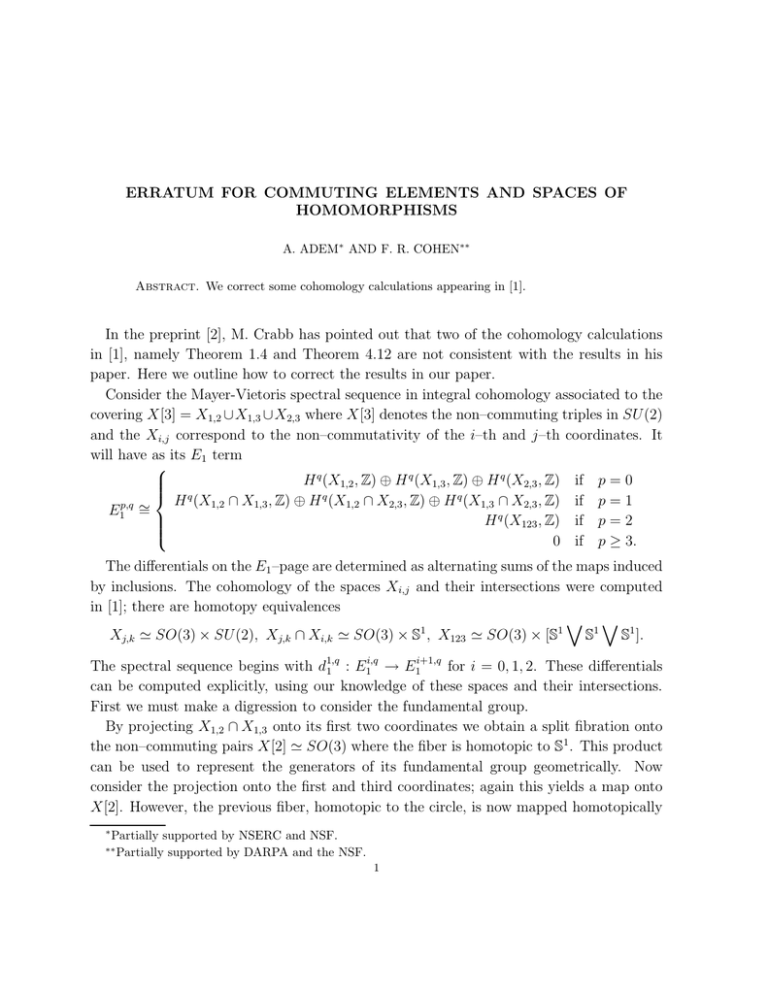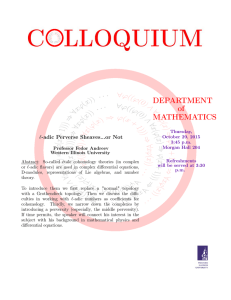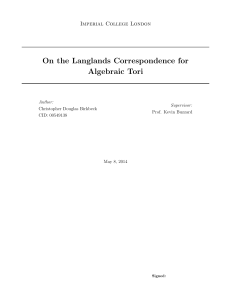ERRATUM FOR COMMUTING ELEMENTS AND SPACES OF HOMOMORPHISMS
advertisement

ERRATUM FOR COMMUTING ELEMENTS AND SPACES OF
HOMOMORPHISMS
A. ADEM∗ AND F. R. COHEN∗∗
Abstract. We correct some cohomology calculations appearing in [1].
In the preprint [2], M. Crabb has pointed out that two of the cohomology calculations
in [1], namely Theorem 1.4 and Theorem 4.12 are not consistent with the results in his
paper. Here we outline how to correct the results in our paper.
Consider the Mayer-Vietoris spectral sequence in integral cohomology associated to the
covering X[3] = X1,2 ∪ X1,3 ∪ X2,3 where X[3] denotes the non–commuting triples in SU (2)
and the Xi,j correspond to the non–commutativity of the i–th and j–th coordinates. It
will have as its E1 term
H q (X1,2 , Z) ⊕ H q (X1,3 , Z) ⊕ H q (X2,3 , Z) if p = 0
q
H (X1,2 ∩ X1,3 , Z) ⊕ H q (X1,2 ∩ X2,3 , Z) ⊕ H q (X1,3 ∩ X2,3 , Z) if p = 1
E1p,q ∼
=
H q (X123 , Z) if p = 2
0 if p ≥ 3.
The differentials on the E1 –page are determined as alternating sums of the maps induced
by inclusions. The cohomology of the spaces Xi,j and their intersections were computed
in [1]; there are homotopy equivalences
_ _
Xj,k ' SO(3) × SU (2), Xj,k ∩ Xi,k ' SO(3) × S1 , X123 ' SO(3) × [S1 S1 S1 ].
i,q
i+1,q
The spectral sequence begins with d1,q
for i = 0, 1, 2. These differentials
1 : E1 → E 1
can be computed explicitly, using our knowledge of these spaces and their intersections.
First we must make a digression to consider the fundamental group.
By projecting X1,2 ∩ X1,3 onto its first two coordinates we obtain a split fibration onto
the non–commuting pairs X[2] ' SO(3) where the fiber is homotopic to S1 . This product
can be used to represent the generators of its fundamental group geometrically. Now
consider the projection onto the first and third coordinates; again this yields a map onto
X[2]. However, the previous fiber, homotopic to the circle, is now mapped homotopically
∗
Partially supported by NSERC and NSF.
Partially supported by DARPA and the NSF.
∗∗
1
ERRATUM FOR COMMUTING ELEMENTS AND SPACES OF HOMOMORPHISMS
2
non–trivially, as it can be identified with the fiber of the projection of X[2] onto SU (2) −
{±1} (which is simply further projection onto the first coordinate). Thus what we have
shown is that if π1 (X12 ∩ X13 ) ∼
= Zw ⊕ Z/2y with these generators corresponding to
the geometric decomposition above, then the inclusions into X12 and X13 induce maps
f1 , f2 : Zw ⊕ Z/2y → Z/2v such that f1 (w) = 0, f1 (y) = v and f2 (w) = v, f2 (y) = v. An
immediate consequence of this is that X[3] is simply connected, as can be seen by using
the Seifert-Van Kampen Theorem for the same decomposition we are considering; indeed
in π1 (X[3]) the homomorphisms induced by the inclusions of the intersections force the
identification of the three generators but they also identify f1 (w) = 0 with f2 (w) = v and
thus the fundamental group is trivial.
Back to the calculation: the key ingredients are that E21,i = 0 for all i ≥ 0 and that
Z if i = 0
0 if i = 0
0 if i = 1
Z/2 if i = 2
Z/2 if i = 1
0 if i = 2
Z4 if i = 3
E22,i ∼
E20,i ∼
=
=
Z/2 if i = 3
0 if i = 4
Z/2 if i = 4
(Z/2)3 if i = 5
0 if i ≥ 5
Z6 if i = 6
0 if i ≥ 7.
It turns out that there is a single non–zero differential on the E2 page, namely d2 : E20,2 →
E22,1 , which is an isomorphism. This differential is forced by the fact that X[3] is simply
connected. There are no other non–trivial differentials: the only possible one would be
E20,5 → E22,4 ; however these terms necessarily appear in the cohomology of X[3] as through
duality the term E20,5 represents the top cohomology of the 3 copies of the top pieces of
Hom(Z2 , SU (2)) which must split off stably from Hom(Z3 , SU (2)). Using this we can
obtain a corrected version of Theorem 5.3 in [1]:
Z if i = 0, 1, 2
Z4 if i = 3
(Z/2)4 if i = 4
∼
Hi (X[3], Z) =
Z/2 if i = 5
Z3 if i = 6
0 if i ≥ 7.
Applying Poincaré–Lefschetz duality to the pair (SU (2)3 , Hom(Z3 , SU (2))) now yields the
revised calculation:
ERRATUM FOR COMMUTING ELEMENTS AND SPACES OF HOMOMORPHISMS
3
Theorem 0.1. The integral cohomology of the space of (ordered) commuting triples in
SU (2) is given by
H i (Hom(Z3 , SU (2)), Z) ∼
=
Z
0
Z3
Z3 ⊕ Z/2
(Z/2)4
Z
0
if
if
if
if
if
if
if
i=0
i=1
i=2
i=3
i=4
i=5
i ≥ 6.
This agrees with the results implied in Crabb’s paper, and is thus a corrected version of Theorem 1.4 in [1]. As a consequence of these corrections, our identification of
Hom(Z3 , SU (3))/S3 (SU (2)) with SU (2) ∧ (S6 − SO(3)) must be modified; as shown by
Crabb this piece is in fact homotopy equivalent to the stunted projective space RP 5 /RP 3 .
The corresponding modification must be made in Example 6.9 and in Example 6.10.
Similarly there is a mistake in the calculation for the cohomology of Hom(Z×F2 , SU (2))
(Proposition 4.11) where F2 is the free group on two generators. The cohomology of the
space SU (2)3 − Hom(Z × F2 , SU (2)) is actually given by
H i (SU (2)3 − Hom(Z × F2 , SU (2)), Z) ∼
=
Z
0
Z
Z3
0
Z ⊕ Z/2 ⊕ Z/2
Z⊕Z
0
if
if
if
if
if
if
if
if
i=0
i=1
i=2
i=3
i=4
i=5
i=6
i ≥ 7.
A differential in the spectral sequence used to calculate this was overlooked. Using duality
as explained in [1] this leads to the corrected version of Theorem 4.12:
ERRATUM FOR COMMUTING ELEMENTS AND SPACES OF HOMOMORPHISMS
4
Theorem 0.2. The integral cohomology of Hom(Z × F2 , SU (2)) is given by
Z if i = 0
0 if i = 1
Z2 if i = 2
Z4 if i = 3
H i (Hom(Z × F2 , SU (2)), Z) ∼
=
(Z/2)2 if i = 4
Z if i = 5
Z ⊕ Z if i = 6
0 if i ≥ 7.
From this analysis it also follows that the corresponding claim (Theorem 4.13) made
about the cohomology of Hom(Z × Fr , SU (2)) where Fr is the free group on r generators
is incorrect; however the correct calculation can be obtained from [2].
We also take this opportunity to correct a typo: in the proof for Proposition 3.1 the
correct value for H1 (Γ2 , Z) is Z/10, not Z/20.
We are grateful to M. Crabb for his interest in our work as well as pointing out the
above mistakes in our cohomology calculations. The rest of the paper is unaffected.
References
[1] A. Adem, F. Cohen, Commuting Elements and Spaces of Homomorphisms, Mathematische Annalen
338, pp. 587–626 (2007).
[2] M. Crabb, Spaces of Commuting Elements in SU (2), preprint 2008.
Department of Mathematics University of British Columbia, Vancouver BC V6T 1Z2,
Canada
E-mail address: adem@math.ubc.ca
Department of Mathematics, University of Rochester, Rochester NY 14627, USA
E-mail address: cohf@math.rochester.edu




